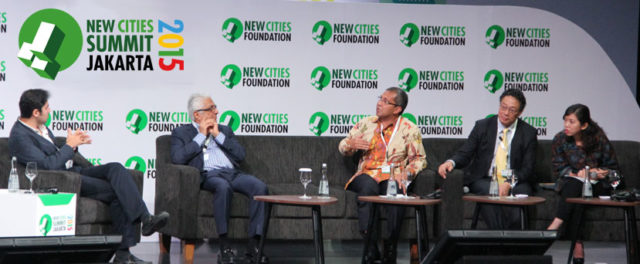Secondary Cities
September 8, 2015 — Blog
This post is part of our Seizing the Urban Moment discussion series, following the fourth edition of the New Cities Summit in Jakarta in June 2015.
There is a very big drop-off between the labor pool of major cities and secondary cities.
Parag Khanna, Managing Partner, Hybrid Reality Pte Ltd
Midsize cities will account for the largest share of urban growth in the next few decades. This session brought together mayors and academic experts to discuss how secondary cities can set themselves apart in a world of mass urbanization.
“There is a very big drop-off between the labor pool of major cities and secondary cities,” noted Parag Khanna, Managing Partner of Hybrid Reality. How do cities compete to get investment and meet their own local needs for growth?
Mohammad Ramdhan Pomanto, the Mayor of Makassar, Indonesia, said that his city is pitching itself as the logistics hub of Indonesia. It is well located within the vast Indonesian archipelago, so that “if you live in Makassar, you can go anywhere”, he argued.
However, Pomanto noted that the big problem for Makassar is that, while it is growing at 9.23% per year, infrastructure is not following economic growth. Secondary cities in Indonesia struggle to get investment from central government, which is too bureaucratic and slow. Public-private partnerships help, but the city still needs much more investment, he said.
Li Tie of the China Center for Urban Development said that subsidiary cities in China are being supported as a way to alleviate pressure on the main cities in the country. Shanghai has 9 million commuters coming into the city each day, swelling its population to 20 million in total. The government is looking to divert as many people as possible into secondary cities so that Shanghai and others are not completely overwhelmed.
The Indian government has not, previously, taken the same approach, said Ajit Gulabchand of the Hindustan Construction Company. The government “romanticized” rural areas and did not support the development of secondary cities. Now, however, “the government has recognized that urbanization is essential, like China did two decades ago.” He concluded that India has now started making its cities “more livable and centers of manufacturing and services.”

Speakers
Ajit Gulabchand, Chairman and Managing Director, Hindustan Construction Company
Mohammad Ramdhan Pomanto, Mayor of Makassar, Indonesia
Li Tie, Director General, China Center for Urban Development
Moderator: Parag Khanna, Managing Partner, Hybrid Reality Pte Ltd – @paragkhanna